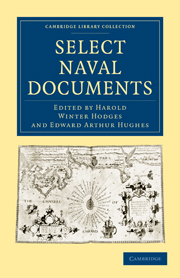Book contents
- Frontmatter
- Preface
- Contents
- LIST OF PLATES
- ILLUSTRATIONS IN THE TEXT
- ABBREVIATIONS
- HENRY VIII
- ELIZABETH
- JAMES I AND CHARLES I
- THE COMMONWEALTH AND PROTECTORATE
- THE RESTORATION NAVY
- WILLIAM III AND ANNE
- THE PEACE PERIOD AND NEED FOR REFORM
- WAR OF AMERICAN INDEPENDENCE, 1778–1783
- REVOLUTIONARY AND NAPOLEONIC WARS
- INDEX
THE RESTORATION NAVY
Published online by Cambridge University Press: 07 September 2010
- Frontmatter
- Preface
- Contents
- LIST OF PLATES
- ILLUSTRATIONS IN THE TEXT
- ABBREVIATIONS
- HENRY VIII
- ELIZABETH
- JAMES I AND CHARLES I
- THE COMMONWEALTH AND PROTECTORATE
- THE RESTORATION NAVY
- WILLIAM III AND ANNE
- THE PEACE PERIOD AND NEED FOR REFORM
- WAR OF AMERICAN INDEPENDENCE, 1778–1783
- REVOLUTIONARY AND NAPOLEONIC WARS
- INDEX
Summary
The very mention of the Restoration Navy at once suggests the name of Samuel Pepys, to whose industry and ability it owed much, and to whose diary, letters, and registers we are indebted for our detailed knowledge of the period. We must not, however, forget that Pepys was the servant of masters who kept in touch with every branch of naval administration. The Duke of York's knowledge of naval affairs is well known. Charles II's interest in the navy was wide, if not deep: after the Duke of York's resignation of the office of Lord High Admiral in 1673, all important matters (and many which were trivial) were decided by the king.
This period is interesting from three main standpoints: the experience of the Second and Third Dutch Wars produced important developments in tactics; the place of Holland as our naval rival was taken by France; and all departments of the navy were subjected to a process of standardisation and systematisation. The restored monarchy inherited from the Commonwealth the strongest navy in existence, the value of which was fully realised. It was necessary to organise this force on a permanent basis. The orders and ‘Establishments’ of this period cover the whole field of naval activity, afloat and ashore. Practice did not always square with theory, partly owing to Charles II's financial weakness, partly owing to the decline in public morality. […]
- Type
- Chapter
- Information
- Select Naval Documents , pp. 71 - 89Publisher: Cambridge University PressPrint publication year: 2009First published in: 1922



